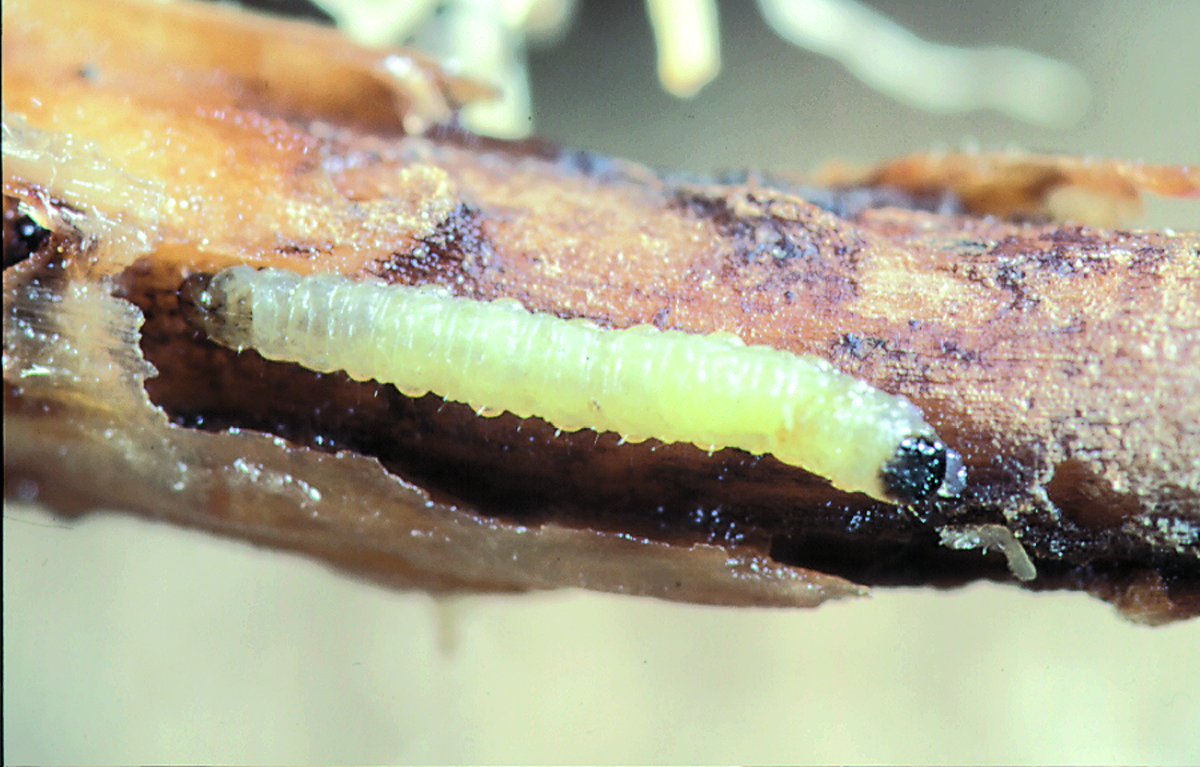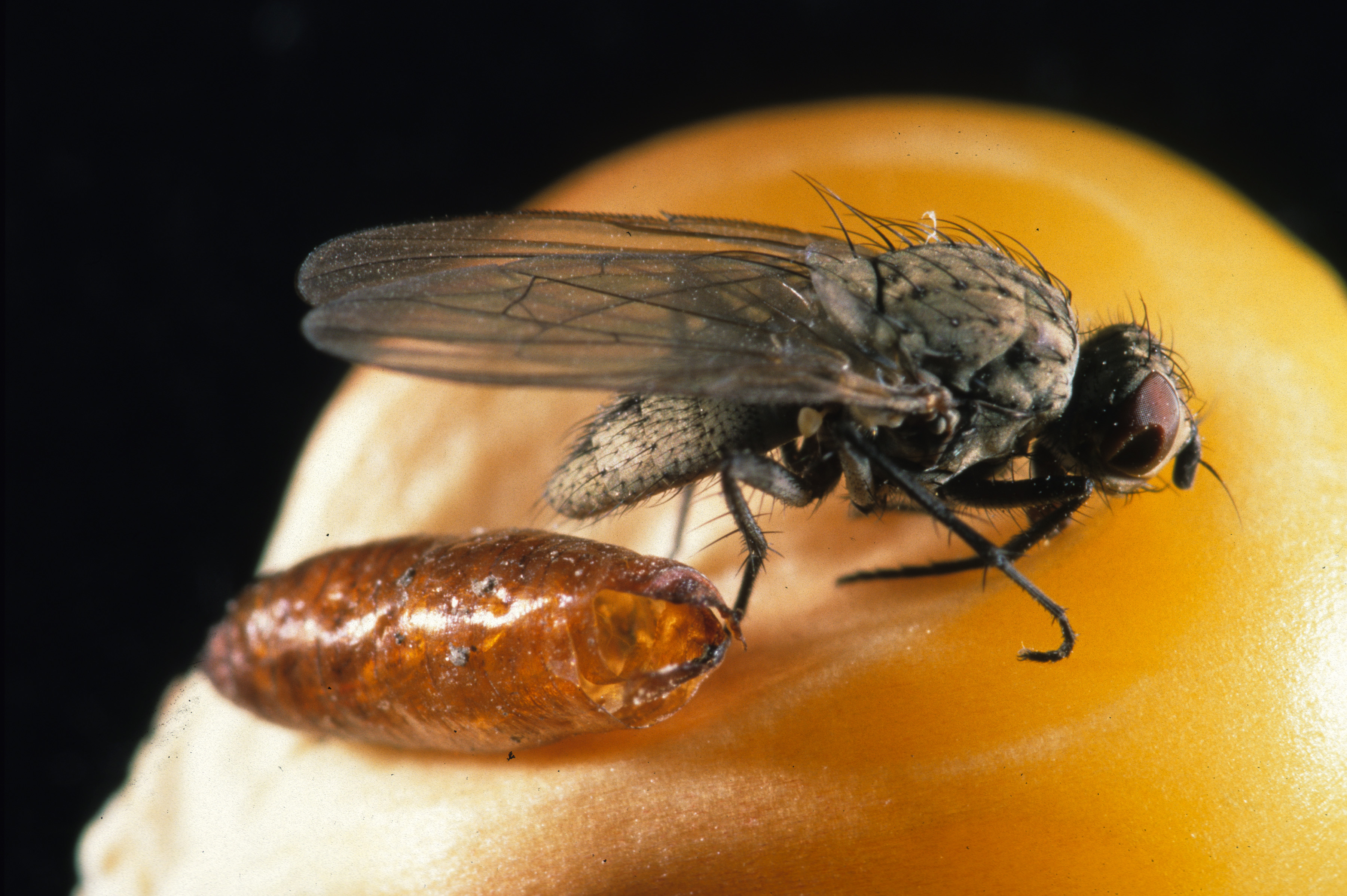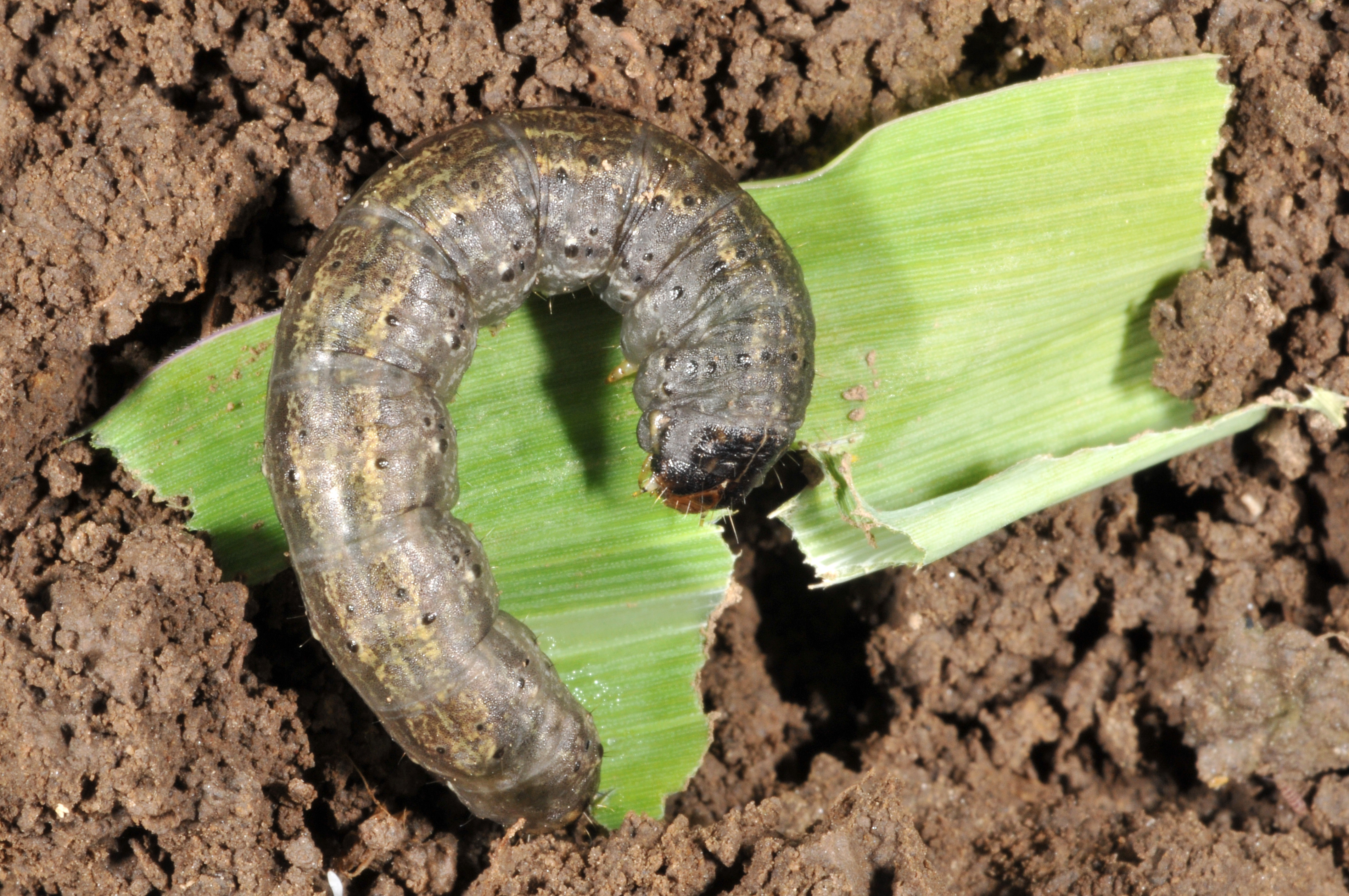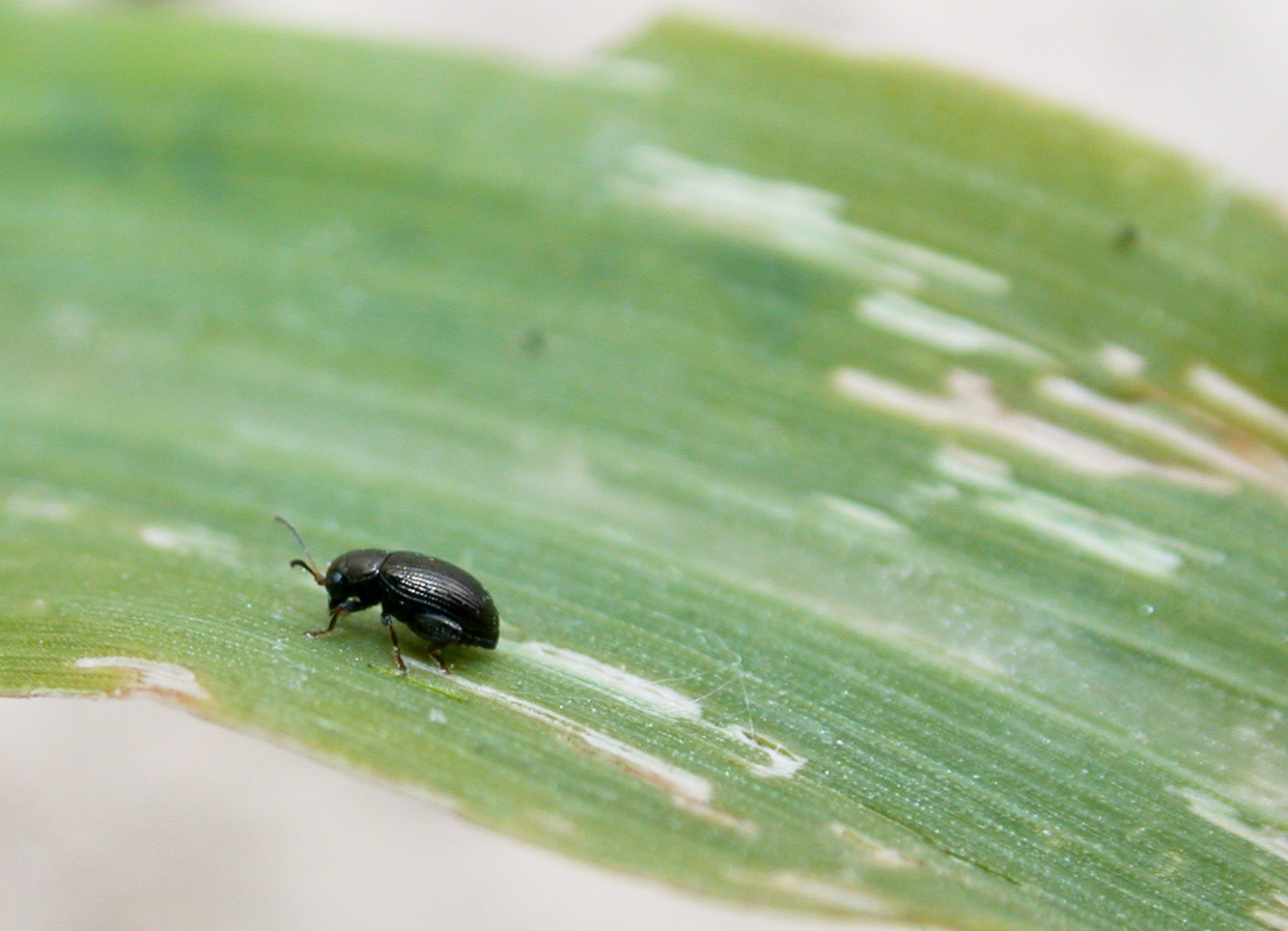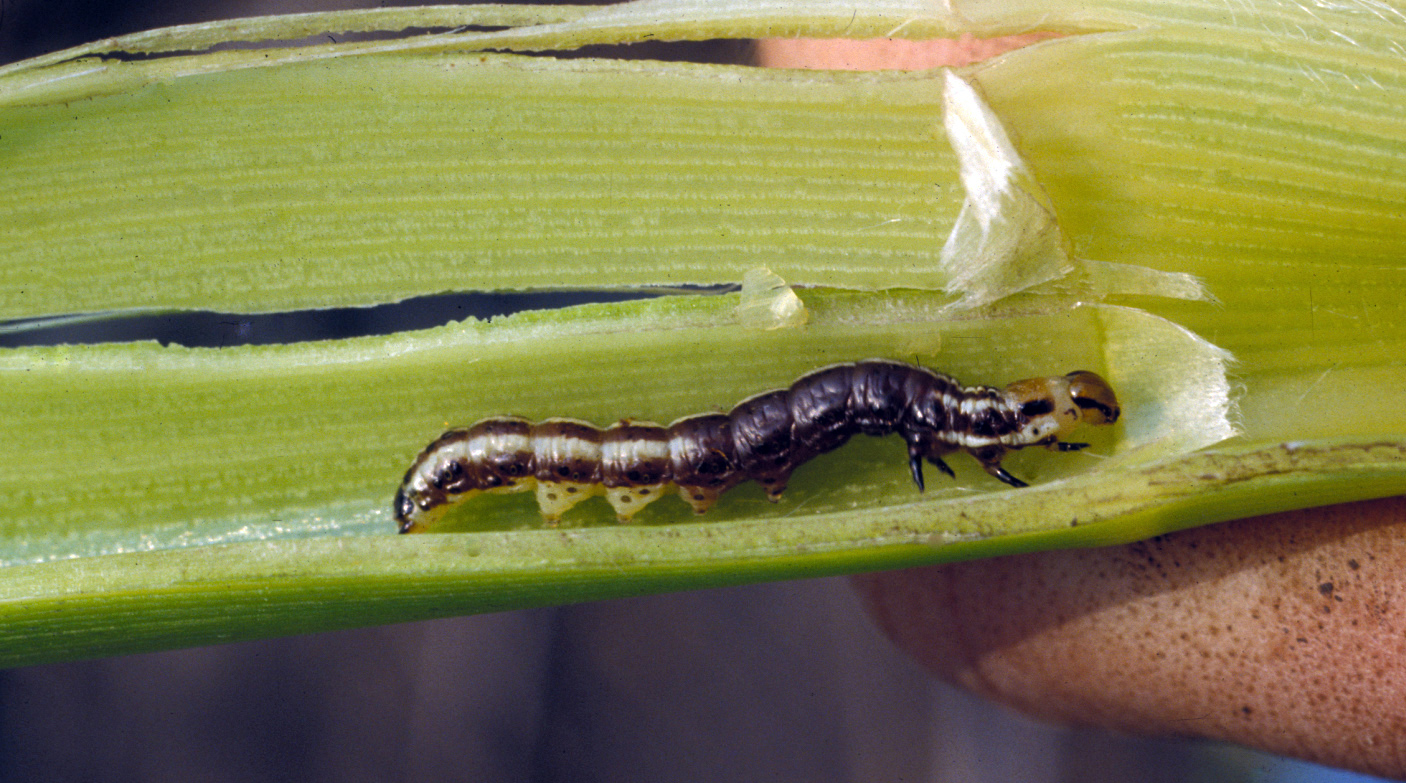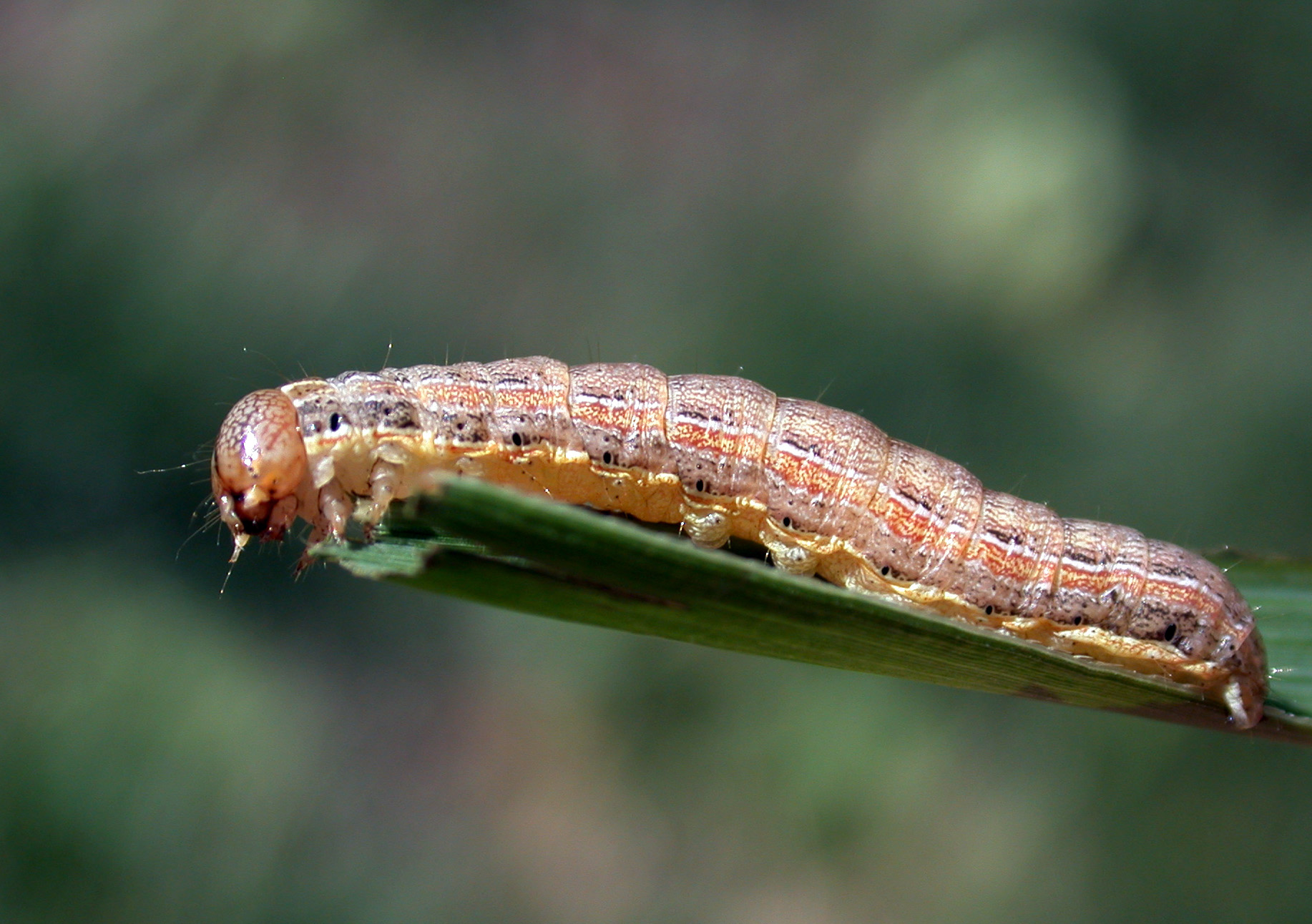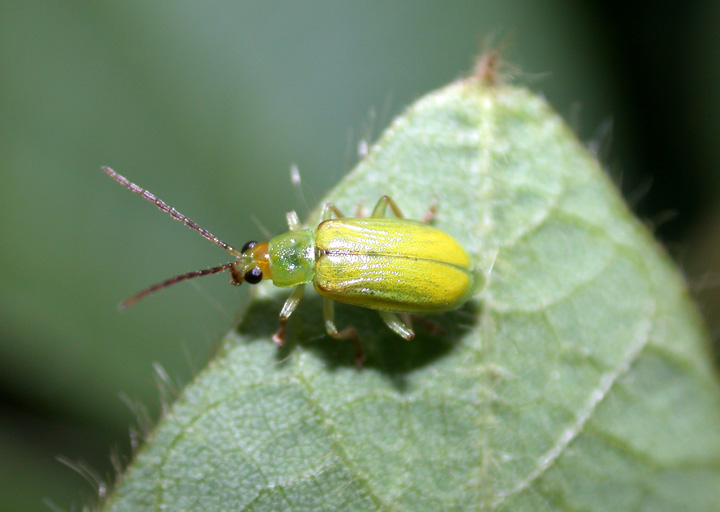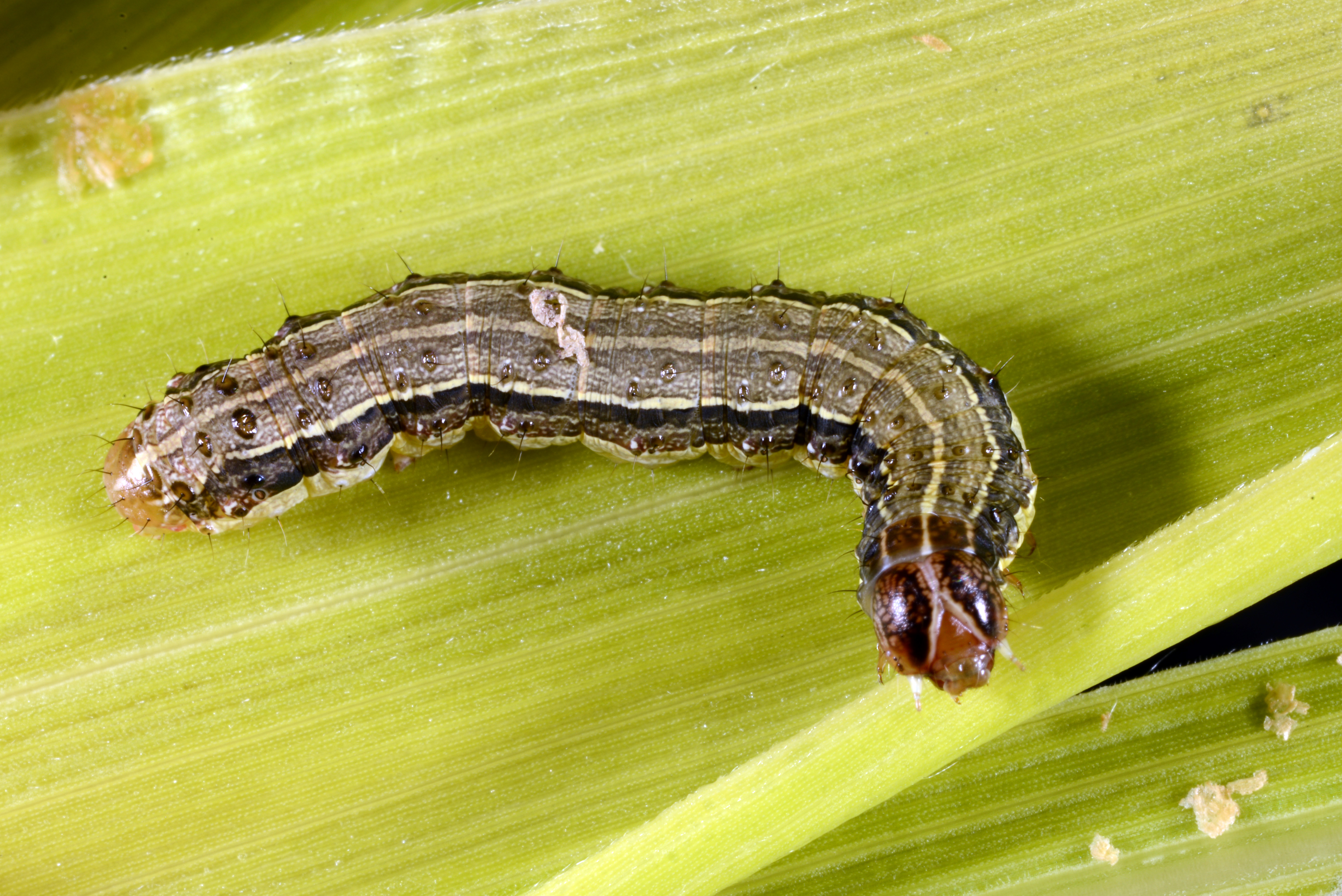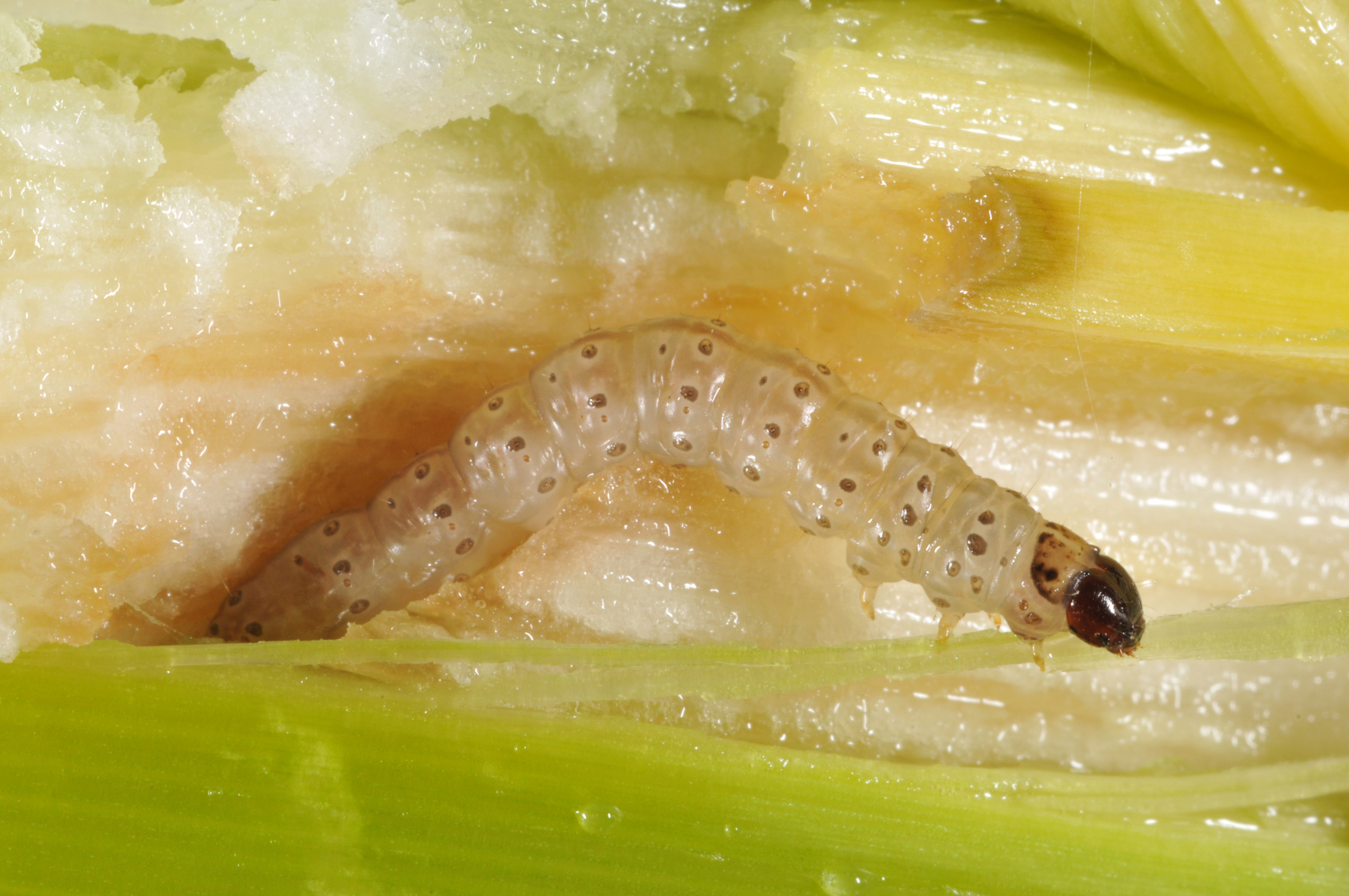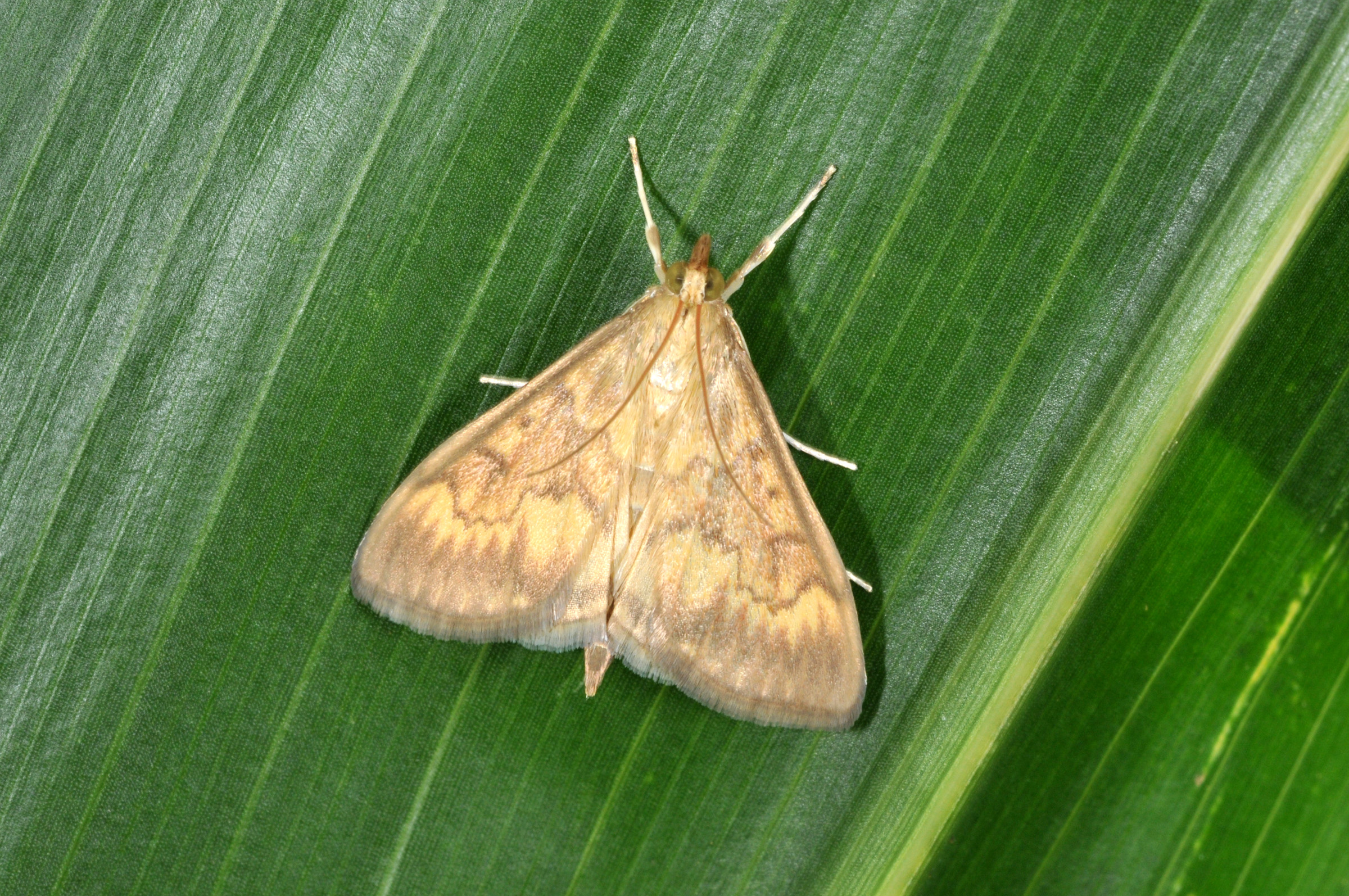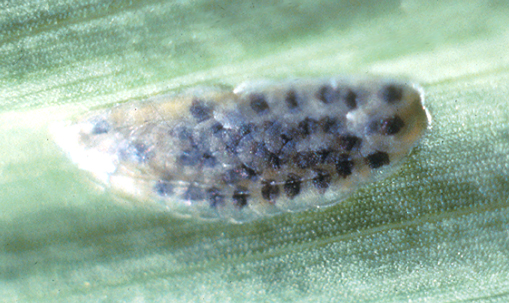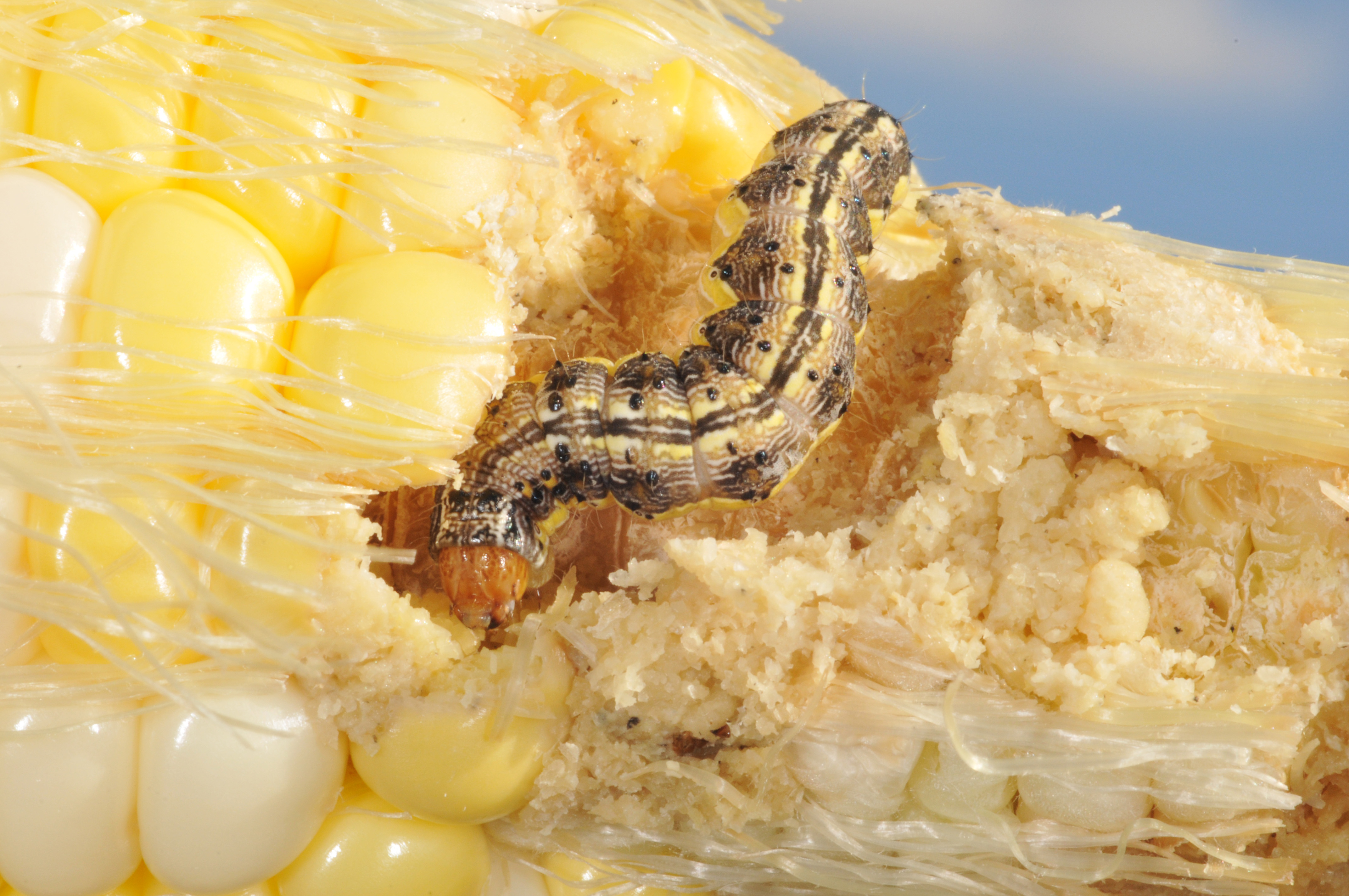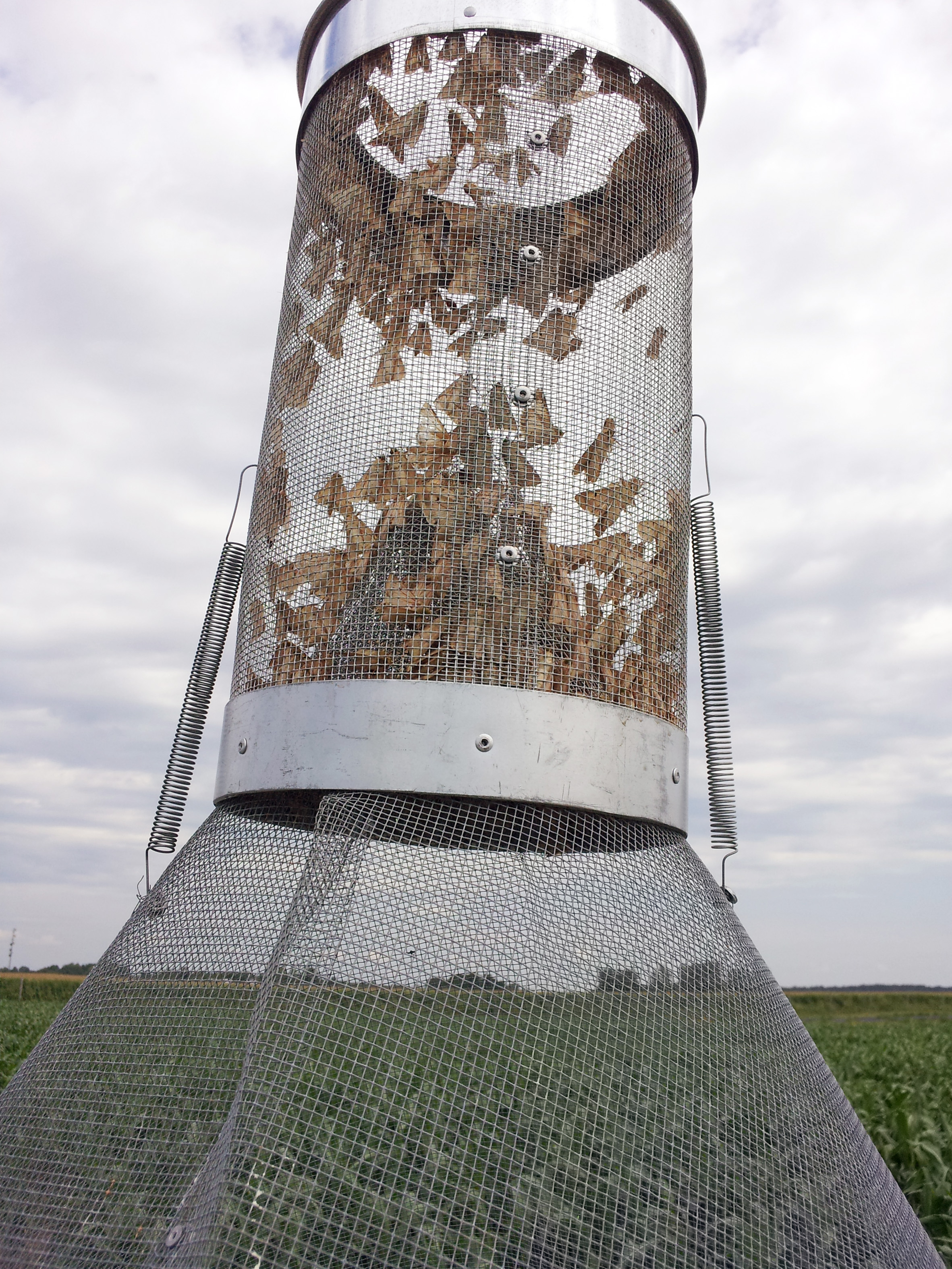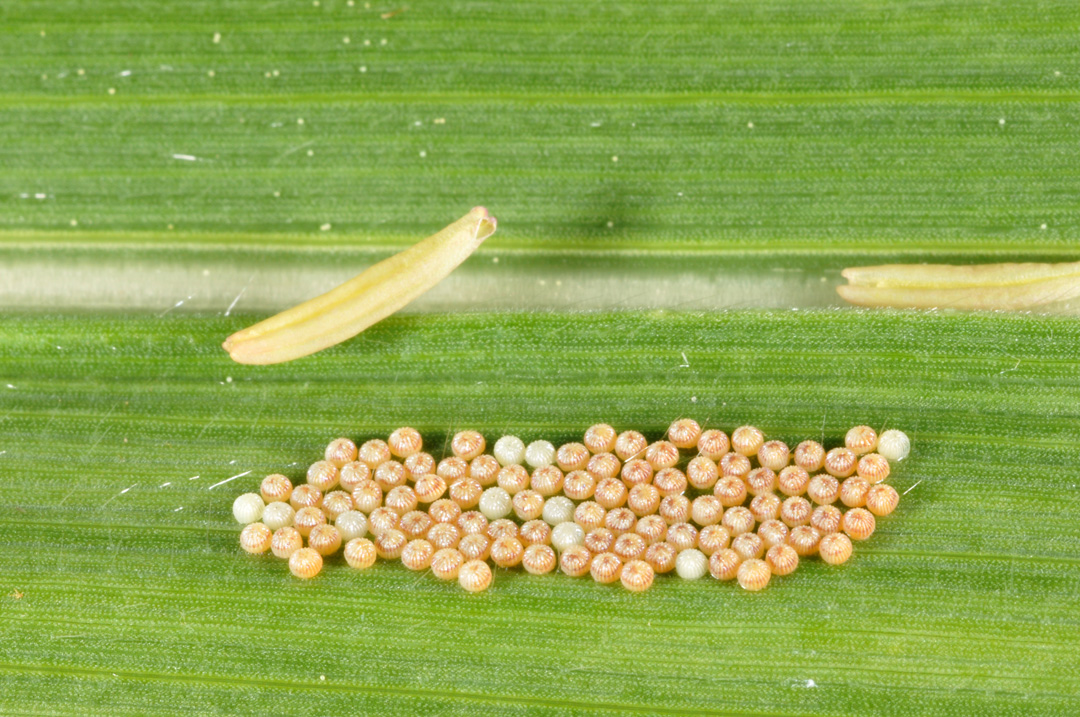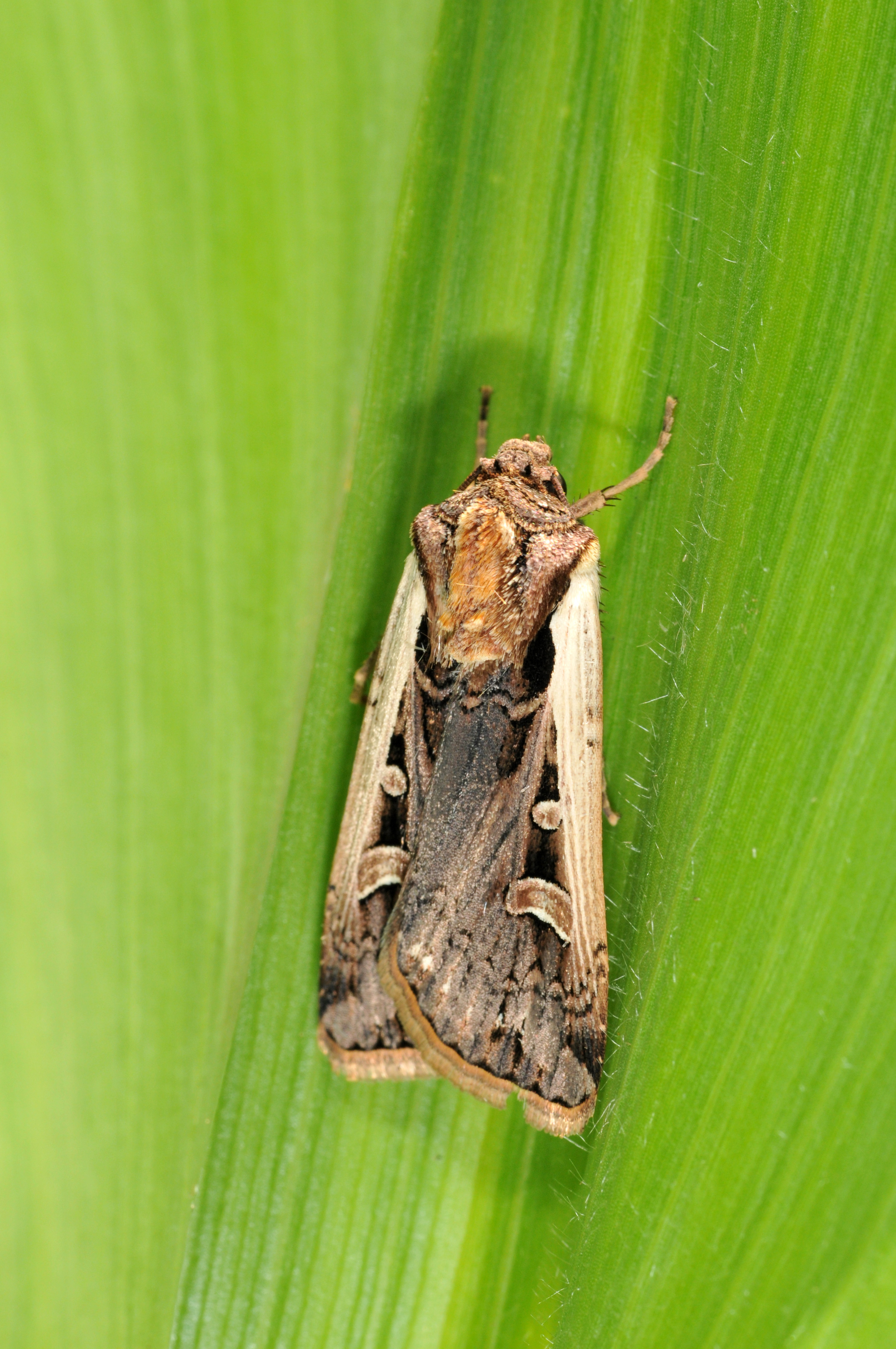Vegetable Insects
Managing Insects in Commercially Grown Sweet Corn
Ricky E. Foster, Extension Entomologists
If you want to view as pdf, click here
Managing insects is one of the most critical aspects of producing marketable sweet corn. Learning to recognize the pests, and their damage coupled with understanding their biology will be valuable when making management decisions. Sweet corn may be attacked by pest insects from the time of planting until harvest. Insects can attack sweet corn seeds, seedlings, roots, stalks, leaves, tassels, silks, and ears so season long management is important. Many of the insects discussed in this bulletin will frequently cause minor damage and some will occasionally cause serious damage.
SEEDCORN MAGGOT
The seedcorn maggot is pale, yellowish-white, legless and can reach 1/4 inch long. The maggot burrows into the seed, often destroying the germ. Damaged seeds may not germinate or may produce weak seedling. The adult is a fly slightly smaller than a house fly. Female flies prefer to lay their eggs in cool, wet soil with high organic matter. Therefore, the likelihood for seedcorn maggot damage is increased in soils that had large amounts of manure applied, a cover crop plowed down, or reduced tillage with previous crop residue.
For early plantings in cool soils, using insecticide treated seed is a good strategy, aside from avoiding the high risk situations outline above. Once seedcorn maggot damage is detected, the only choices are to either live with the reduced stand or replant the field.
Corn Rootworm larva
(Photo credit: J. Obermeyer)
WIREWORM
Wireworms are slender, hard bodied, wire-like beetle larvae that are yellow to brown and range from 1/2 to 1-1/2 inches long. They will feed on the germ, hollow out entire seeds, or tunnel into roots and shoots of seedlings. Damaged seedlings will usually wilt, with the symptoms first showing up on the youngest leaves. Damage to either seeds or seedlings may result in the death of the plant.
Wireworms typically are more serious in fields that were grass, alfalfa, or fallow the previous year. If wireworms have been a problem in the past, the potential for wireworm problems can be assessed by putting bait stations in the field 2 to 3 weeks prior to planting. Bait is either untreated wheat or corn. Bury a cup of flour 6 inches deep in 4 or 5 areas, and flag the sites. Dig the baits in about 10 days, place the flour and soil on black plastic and look for wireworms. A video that explains the trapping process can be viewed below.
Wireworm Flour Bait Trap Sorting
(Movie credit: Christian Krupke and John Obermeyer)
Seedcorn maggot (top) larva, (bottom) pupa, and adult.
(Photo credit: J. Obermeyer (Larva, pupa) and B. Christine (adult) )
Seedcorn maggot (top) larva, (bottom) pupa, and adult.
(Photo credit: J. Obermeyer (Larva, pupa) and B. Christine (adult) )
CORN ROOTWORM LARVAE
Adult northern and western corn rootworm beetles can lay eggs in cornfield soil in the year prior to planting sweet corn, resulting in larval damage during the subsequent season. The larvae hatch in early summer and damage plants by tunneling into roots, often pruning the roots back to the crown. This root damage reduces water and nutrient uptake and can cause the plants to be stunted. Severe damage can also result in plants falling over. If silk is continually protected through harvest and the fodder is immediately cultivated, there should minimal egg laying and little or no danger of larval damage in the following year.
Rootworm larval damage in the planting season can be avoided by planting around June 21 or later. Soil insecticides are available but are usually not needed for sweet corn.
Overall, rootworm populations are much less of a threat than in the past due to the widespread adoption of Bt-rootworm technology in field corn.
Wireworm larva.
(Photo credit: J. Obermeyer)
CUTWORMS
There are several species of cutworms that feed on corn, but the most common is the black cutworm. Control for all species is the same. The black cutworm reaches a length of 2 inches, varies in color from light gray to almost black, and has coarse granules visible on the skin. Small larvae eat irregular holes on leaves of seedlings, but larger larvae may cut plants off either above or below ground level. Plants that are cut off above the growing point will regrow, but those cut off below the growing point are dead. As a result, larger seedlings generally are more seriously damaged by cutworms than small seedlings. Cutworms tend to be more serious in fields with reduced tillage, have winter annual weeds, especially chickweed, present prior to spring tillage, and have a previous history of cutworm problems.
Scout for cutworms at least weekly immediately after crop emergence by checking 20 consecutive plants in 5 areas of the field. Look for either leaf feeding or cut plants. Try to find the cutworm that has damaged the plant by digging in the soil around any damaged plant. It is better to treat before cutting starts, based on the holes created by the small larvae. Generally, a foliar rescue treatment is justified if 5 or more of 100 plants are damaged. Remember that the smaller the cutworms, the more feeding they will do in the future. If the cutworms are large, they are nearing completion of the larval stage and may only do a little more feeding. Do not use a seed treatment or a preventive soil insecticide specifically for cutworm management; the chances of having a problem are relatively low. Scouting for this pest can cease when corn reaches the 6-leaf stage of development.
Black cutworm curled with cut plant.
(Photo credit: J. Obermeyer)
Black cutworm open with cut plant
(Photo credit: J. Obermeyer )
CORN FLEA BEETLE
Flea beetles are tiny (about 1/16 inch long) black beetles with enlarged hind legs that allow them to jump long distances. They feed on seedlings and mature plants by stripping the green top layer from the leaves, resulting in irregular brown or grey lines. Heavy feeding damage can stunt or kill young plants. More important, corn flea beetles can transmit a bacterium that causes a disease named Stewart’s wilt. Sweet corn varieties vary greatly in their susceptibility to Stewart’s wilt.
Overwintering flea beetles suffer significant mortality during cold winters. To determine the potential for wilt problems in your area, add the average monthly temperatures (°F) for December, January, and February. If the sum of those 3 numbers is less than 90, then the disease can be expected to be mild. If the sum is between 90 and 100, then epidemics of moderate severity are expected. If the sum is greater than 100, then the disease can be expected to be severe and destructive. Check with your seed dealer for varieties with disease resistance. Use those varieties for early plantings following a mild winter. In those fields where a susceptible variety is being grown and moderate or severe disease pressure is expected, monitor the field on a regular basis. When beetles are first noticed, apply a foliar insecticide. No economic threshold is available, but populations greater than 10 beetles per plant will usually cause losses, even when a Stewart’s wilt resistant variety is grown.
Corn flea beetle
(Photo credit: J. Obermeyer)
STALK BORER
The stalk borer is a caterpillar that attacks seedlings on rare occasions. The caterpillars have prominent stripes running lengthwise on the body that are interrupted in the middle by a dark purple “saddle.” They bore through the unopened leaves so that as the leaves expand and elongate a series of holes appear across the blades. The top or “flag” leaf wilts and droops, and the seedling may eventually wilt. If the larva bores deep into the stalk, the plant may die or not produce an ear.
Stalk borers usually confine their damage to field margins or near fence lines or waterways. Excessively grassy corn fields may have damage throughout.
If stalk borers have not yet entered the stalk, they may be controlled with foliar insecticides. Treat field areas where 15-20% of plants show leaf feeding. If the larvae have bored into the stalks, then no control is possible.
Stalk borer
(Photo credit: J. Obermeyer)
ARMYWORM
Armyworm moths that overwinter in Indiana as pupae and migrate to the Midwest from southern states in April and May lay eggs primarily on grass plants. In early summer the caterpillars reach a length of 1-1/2 inches and are dull green to brown sometimes tinged with pink with alternating light and dark stripes running the length of their backs. They feed on the leaves of seedling and young corn, giving it a ragged appearance, or, under heavy pressure, eat everything except the midrib.
Armyworm can damage sweet corn from early to late summer. Typically, problems occur when the caterpillars have developed on small grains, grass cover crops, or grassy weeds and then move to corn when the host plants mature, are killed by herbicides, or are completely consumed. Watch for large numbers of caterpillars crawling toward corn at these times, and look for damage first in those areas of the field near a small grain field or next to a fence row or waterway. Grassy fields tend to have greater armyworm infestations. Foliar insecticides can be applied to those areas of the field where more than 5 percent of the plants show feeding damage, larvae are less than 3/4 inch long, and corn is less than 6 inches tall.
Armyworm larva
(Photo credit: J. Obermeyer)
CORN ROOTWORM BEETLES
In addition to the rootworm larval damage described previously, the beetles can infrequently interfere with pollination by feeding on silks. However, in recent years, lower populations have rarely caused problems. If beetles are present and are clipping green silks to within 1/2 inch of the husk, then foliar insecticide treatment is justified. Other pests that feed on silk and kernels at this time will also be controlled.
Northern corn rootworm beetle
(Photo credit: J. Obermeyer)
Western female and male beetles
(Photo credit: J. Obermeyer)
CORN LEAF APHID
Corn leaf aphids can occur in large numbers on tassels of sweet corn plants. The feeding they do with their sucking mouthparts is usually not important. However, they secrete a sticky substance known as “honeydew” that can coat the anthers and reduce the amount of pollen that is dispersed. Treat fields if they are less than 50 percent pollinated and at least 50 percent of the plants are infested with at least 50 aphids per plant (“The Rule of 50’s”). The normal spray program for other pests of silk and ears often will clean up aphid infestations. Lannate will provide good aphid control.
Corn leaf aphids
(Photo credit: J. Obermeyer)
FALL ARMYWORM
The fall armyworm does not overwinter in Indiana. Moths begin migrating northward from southern Florida or Texas or from Mexico or Central America in early spring. They may go through a generation at one or more intermediate locations before reaching Indiana. Infestations usually are not noticed until mid-to late summer. The larvae are smooth-skinned caterpillars varying from light green to nearly black with stripes of various colors that run the length of their bodies. The head has a prominent, white, inverted, Y-shaped line. There are also four black spots arranged in a rectangle on the back of the last body segment.
The caterpillars feed on sweet corn at any stage of development. Damage during the early- to mid-whorl stage must be heavy before yield or quality of the crop will be affected. However, feeding during the late-whorl to tasseling stage can severely affect yield. Caterpillars present during those stages may migrate to the ear region and damage the ear. Populations as low as 0.2 - 0.5 larvae per plant can significantly reduce yield of marketable ears. Larvae will enter the ear at the tip or through the side making a large, ragged hole.
The key to fall armyworm management is control during the late whorl or tasseling stage. If they are not controlled before silking, it is very difficult to protect the ears, even with frequent sprays. Fortunately, fall armyworms are not often present in large numbers in Indiana. Monitor late-planted sweet corn for fall armyworms during the mid- to late-whorl stages.
Fall armyworm larva
(Photo credit: J. Obermeyer)
EUROPEAN CORN BORER
European corn borers have diminished in importance since the introduction and widespread adoption of Bt field corn and rarely need to be managed with insecticides.
European corn borers overwinter as larvae and pupate in May. Moths emerge in late May and begin flying and laying eggs in early June. The adult female is a creamy, yellowishbrown moth approximately 3/4 inch long. It has a stout body and a wing span of a little more than 1 inch. Two dark serrated lines run across the outer one third of the forewings. The moths from this first generation look for the oldest (tallest) corn on which to lay their eggs. The eggs are laid in masses of 15 to 30 eggs usually on the underside of the leaves. The eggs in a mass overlap like fish scales. The larvae that emerge from these eggs will feed on leaves in the whorl while they are young and later will bore into the stalk or into the ear if present. The larvae are flesh-colored with small, round, dark spots on each of the body segments. Mature larvae are about 1 inch long.
Sweet corn can tolerate a large amount of injury when the plants are in the early- to mid-whorl stage. However, treatment is justified during the mid to late-whorl stage if 15 percent or more of the plants show larval feeding and borers are still present. If you use a slower acting Bacillus thuringiensis based insecticide, lower the threshold to 10 percent.
Second generation moths begin flying in mid July, and larvae are present beginning in late July. This generation is usually more important on sweet corn. In this generation, the moths look for the youngest fields available for egg laying. Eggs, again, will be laid on the underside of leaves, usually near the ear. When the plant starts to tassel, a larva feeding in the whorl is pushed out and must either hide behind a leaf sheath or bore into the ear. It is during this movement that it is most vulnerable to insecticides. Larvae will bore a fairly small, nearly inconspicuous entrance hole into the ear through the tip, side, or shank, unlike fall armyworm larvae.
European corn borer larva damage
(Photo credit: J. Obermeyer)
European corn borer adult female
(Photo credit: J. Obermeyer)
European corn borer egg mass
(Photo credit: J. Obermeyer)
CORN EARWORM
With the diminished importance of the European corn borer, corn earworm is now the most important insect pest of sweetcorn. See https://extension.entm.purdue.edu/publications/E-31.pdf. The adult corn earworm is a yellowish-brown moth with a wingspan of 1-1/2 inches. The wings are light tannish brown with a prominent, dark, “comma” shaped mark on the forewing that is more prominent on the male. Infestations in Indiana develop from pupae that overwinter in southern and central Indiana and moths from southern regions of the US. Moths prefer to lay eggs singly on fresh, green silks. When the eggs hatch 2 to 5 days later, the young larvae follow the silk channel to the tip of the developing ear. There they feed, consuming kernels and fouling the kernels with excrement. Frequently, the damage will be confined to the terminal inch. The ear can still be saved if the damaged tip is removed. The caterpillars vary considerably in color, ranging from light green to tan, brown, pink, maroon, or nearly black, with light and dark stripes running lengthwise on the body. The skin is coarse and has many hair-like projections. They grow to nearly 1-1/2 inches long.
Commercial sweet corn growers are encouraged to use pheromone traps to monitor for the presence of CEW moths. Put the trap up a week before the first crop of sweet corn begins to tassel. This recommendation is true no matter how early the first crop reaches maturity. In recent years, considerable numbers of earworm moths have been caught in traps very early in the season. In major corn producing states like Indiana, sweet corn is generally surrounded by many acres of dent corn. Therefore, the attractiveness of the dent corn to earworm moths for egg laying has a major influence on how susceptible sweet corn is to earworm damage. Early in the season, before the neighboring dent corn begins to silk, insecticides should be applied to sweet corn when fresh silks are present and 1 moth per night is being caught in the pheromone trap. In the middle of the season when the dent corn is producing fresh silks, insecticides are not necessary unless 10 moths per night are being captured in the pheromone trap. After pollination is complete in dent corn, the spray threshold should again be reduced to 1 moth per night, although moth catches are usually quite high this late in the season (late August and September).
For many years, sweet corn growers obtained excellent control of corn earworms with pyrethroid insecticides such as Ambush/Pounce, Asana, Baythroid, Capture/Brigade, Mustang Maxx, and Warrior. In the last several years, these products have produced unsatisfactory results because of the development of resistance. In recent trials, Coragen and Radiant have provided the highest levels of control, with Belt also giving good results. For organic growers, the only product available with reasonably good control is Entrust.
When moth catches in the pheromone trap are exceeding the threshold (1 or 10 moths per night), the first application should be made when about 30-50% of the plants are showing silks. Subsequent applications should be made every 2-5 days, depending on the number of moths being caught in the trap and the temperature, with more moths and higher temperatures shortening the interval between sprays. Moth catches will occasionally reach levels of 100 per night or higher. In these situations, the interval between sprays should be reduced to 2 days. Sprays should be continued until most of the silks have turned brown and are no longer attractive to the moths to lay eggs. The reason that multiple applications are needed is not because the insecticides cease to be effective, but because susceptible untreated silks continue to appear at about 1 inch per day.
Corn earworm larva
(Photo credit: J. Obermeyer)
Corn earwom moth
(Photo credit: J. Obermeyer)
Pheromone trap to monitor corn earworm moths
(Photo credit: J. Obermeyer)
WESTERN BEAN CUTWORM
The western bean cutworm is a relatively new pest in Indiana, first observed in 2006. Moths begin flying and laying 20 to 40 eggs in masses near the whorl in late June and continue through early August. The masses are initially cream colored changing to purple near hach. Newly-hatched larvae feed on the tassel, corn pollen, behind the leaf sheaths, and silks. As the larvae get larger, they may feed on the ear tips or enter the ear through the side of the husk. Mature caterpillars will have 2 brown rectangles on the plate behind the head. There may be 3 or more caterpillars per ear unlike corn earworm that usually has 1 or 2 caterpillars per ear. When they reach maturity, they will chew their way out of the husk and overwinter in the soil as pupae.
Moth activity at mid summer can be monitored with pheromone traps. The treatment threshold with foliar insecticides is 4 percent of plants with egg masses or small caterpillars. Like other ear-feeding caterpillars, western bean cutworm larvae must be controlled before they enter the ear. Insecticides used for earworm control are effective against western bean cutworm. Applications should be targeted at the late whorl - early silking stages for optimum control.
Western bean cutworm eggs
(Photo credit: J. Obermeyer)
Western bean cutworm adult
(Photo credit: J. Obermeyer)
Western bean cutworm larvae
(Photo credit: J. Obermeyer)
Western bean cutworm damage
(Photo credit: J. Obermeyer)
BT SWEET CORN
There are varieties of sweet corn with an inserted gene that cause plants to produce the same toxin as the common soil bacterium, Bacillus thuringiensis, (Bt.). While this gene will provide some control of corn earworms, many of the varieties that contain a single Bt gene do not provide sufficient control and need to have a regular insecticide spray program used with it. Some of the newer Bt varieties have multiple genes for earworm control (as well as European corn borer and other caterpillar pests) and in many situations these will provide excellent levels of control. Since moth counts in the pheromone traps are often very high late in the season, growers should consider planting Bt varieties in those later plantings. Along with a regular insecticide spray program, this should achieve a high level of control.
See ID-56 for information regarding specific insecticide recommendations:Northern corn rootworm Diabrotica barberi Smith and Lawrence
Western corn rootworm Diabrotica virgifera virgifera LeConte
Seedcorn maggot Delia platura (Meigen)
Wireworm Melanotus spp.
Agriotes mancus (Say)
Limonius dubitans(LeConte)
Black cutworm Agrotis ipsilon (Hufnagel)
Corn flea beetle Chaetocnema pulicaria Melsheimer
Stalk borer Papaipema nebris (Guenee)
Armyworm Pseudaleti unipunctata (Haworth)
Fall armyworm Spodoptera frugiperda (J.E. Smith)
European corn borer Ostrinia nubilalis (Hubner)
Corn earworm Helicoverpa zea (Boddie)
Corn leaf aphid Rhopalosiphum Maidis (Fitch)
Western bean cutworm Richia albicosta (Smith)
READ AND FOLLOW ALL LABEL INSTRUCTIONS. THIS INCLUDES DIRECTIONS FOR USE, PRECAUTIONARY STATEMENTS (HAZARDS TO HUMANS, DOMESTIC ANIMALS, AND ENDANGERED SPECIES), ENVIRONMENTAL HAZARDS, RATES OF APPLICATION, NUMBER OF APPLICATIONS, REENTRY INTERVALS, HARVEST RESTRICTIONS, STORAGE AND DISPOSAL, AND ANY SPECIFIC WARNINGS AND/OR PRECAUTIONS FOR SAFE HANDLING OF THE PESTICIDE.
March 2016

It is the policy of the Purdue University Cooperative Extension Service that all persons have equal opportunity and access to its educational programs, services, activities, and facilities without regard to race, religion, color, sex, age, national origin or ancestry, marital status, parental status, sexual orientation, disability or status as a veteran. Purdue University is an Affirmative Action institution. This material may be available in alternative formats.
This work is supported in part by Extension Implementation Grant 2017-70006-27140/ IND011460G4-1013877 from the USDA National Institute of Food and Agriculture.
1-888-EXT-INFO
www.extension.purdue.edu
Order or download materials from www.the-education-store.com

